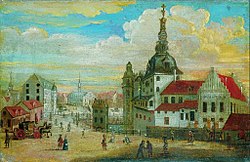Copenhagen Castle
You can help expand this article with text translated from the corresponding article in Danish. (June 2012) Click [show] for important translation instructions.
|
| Copenhagen Castle | |
|---|---|
 Copenhagen Castle painted in 1698 by unknown artist | |
 | |
| General information | |
| Town or city | Copenhagen |
| Country | Denmark |
| Construction started | Late 14th century |
| Demolished | 1731 |
Copenhagen Castle (Template:Lang-da) was a castle on Slotsholmen in Copenhagen, Denmark, built in the late 14th century at the site of the current Christiansborg Palace.
During the years after the demolition of Bishop Absalon's Castle by the Hansa League in 1369, the ruins on the island were covered with earthworks, on which the new stronghold, Copenhagen Castle, was built.
The castle had a curtain wall and was surrounded by a moat and with a large, solid tower as an entrance gate. The castle was still the property of the Bishop of Roskilde until King Eric of Pomerania usurped the rights to the castle in 1417. From then on the castle in Copenhagen was occupied by the king.
The castle was rebuilt several times. King Christian IV, for example, added a spire to the large entrance tower, which under the name of the Blue Tower gained a reputation as a prison. In the 1720s, Frederik IV entirely rebuilt the castle, but it became so heavy that the walls began to give way and to crack. It became therefore evident to Christian VI, Frederik IV's successor, immediately after his accession to the throne in 1730, that an entirely new castle had to be built.
The demolition of the overextended and antiquated Copenhagen Castle was commenced in 1731 to make room for the first Christiansborg Palace.
